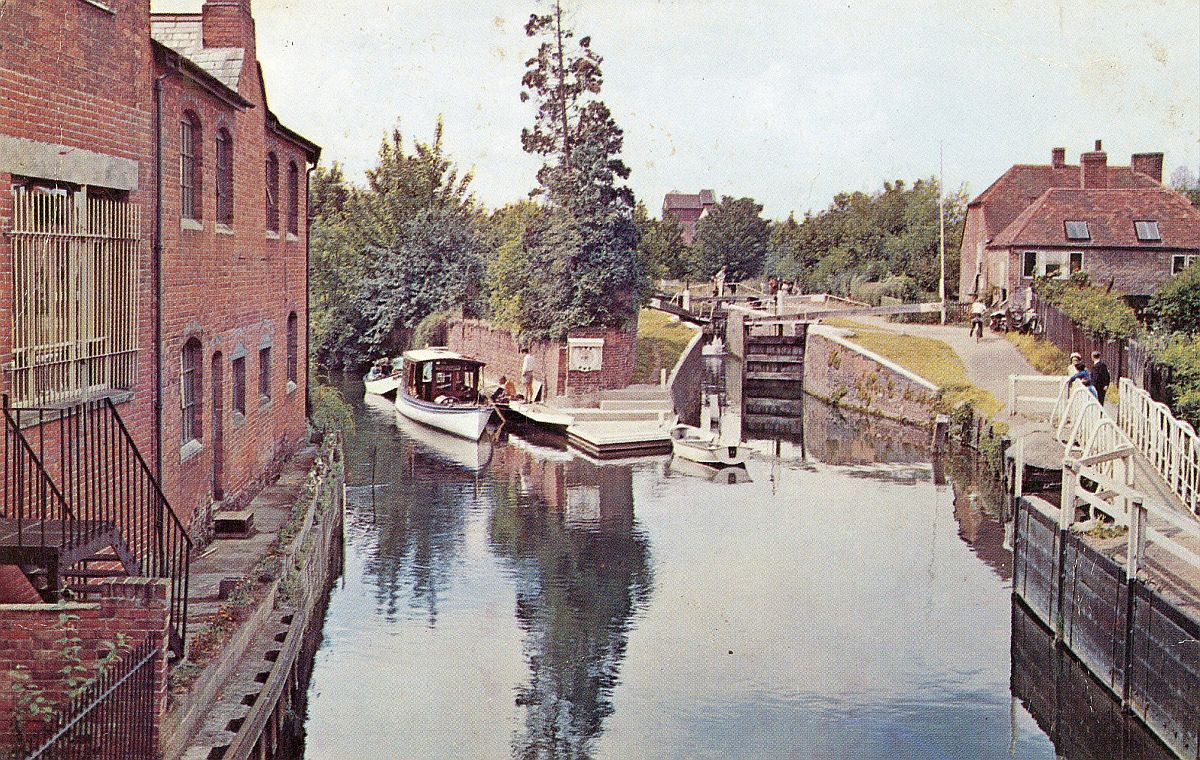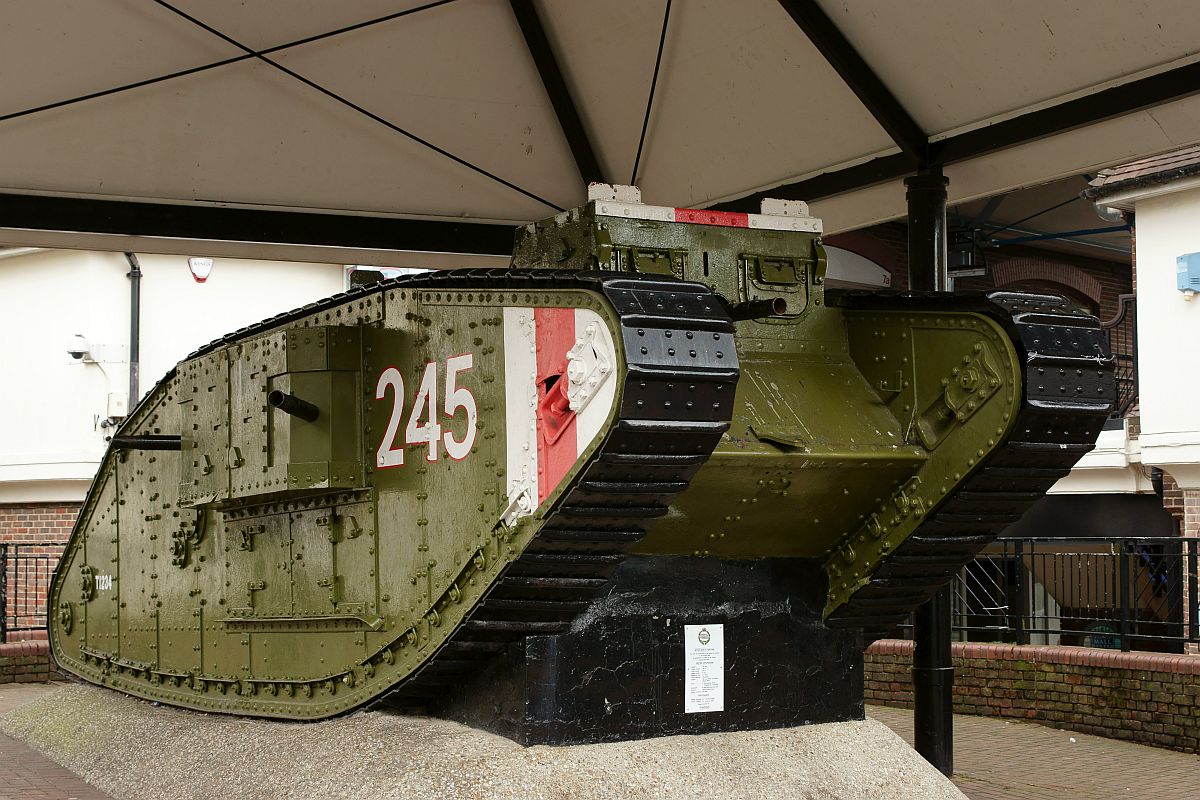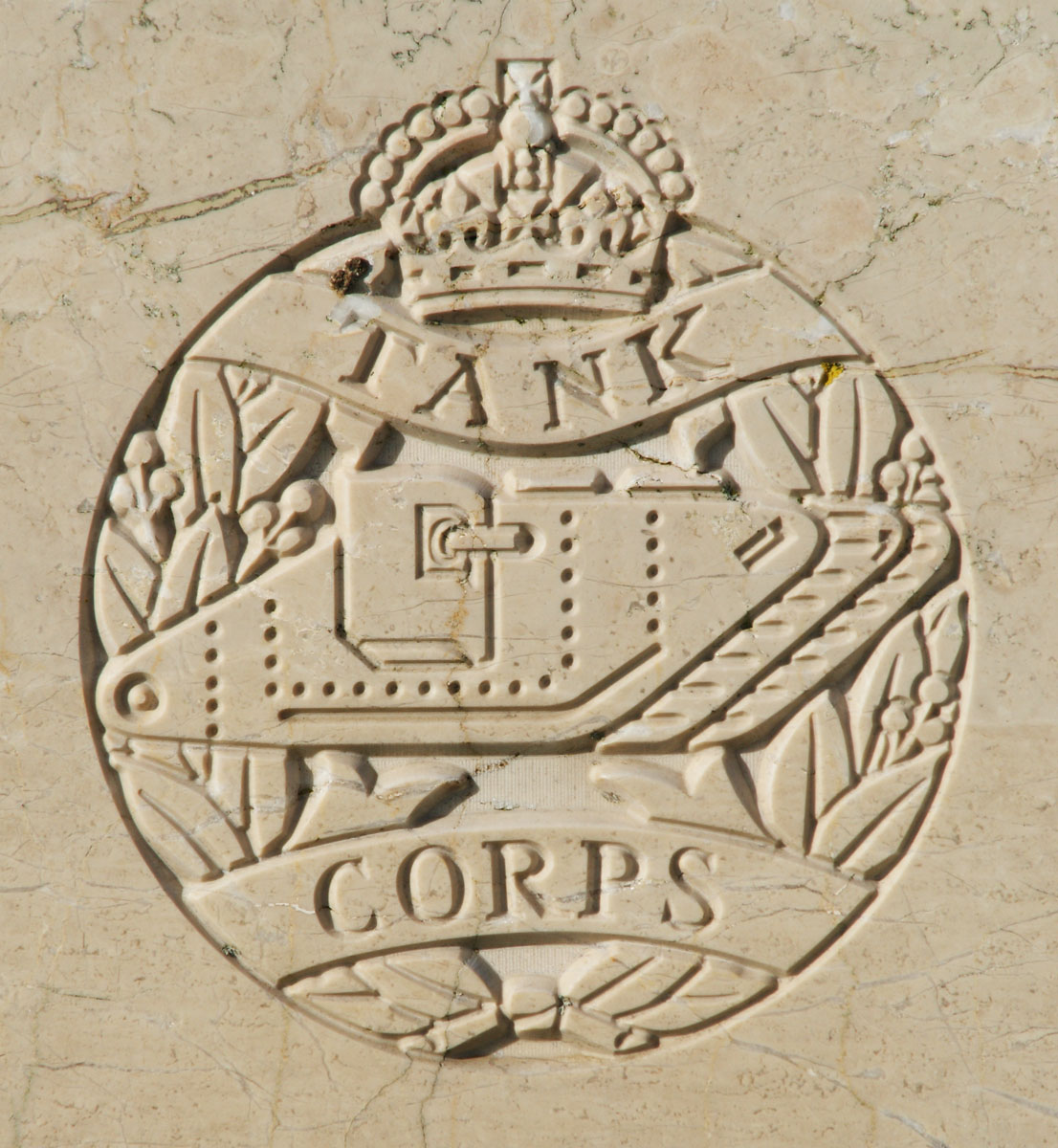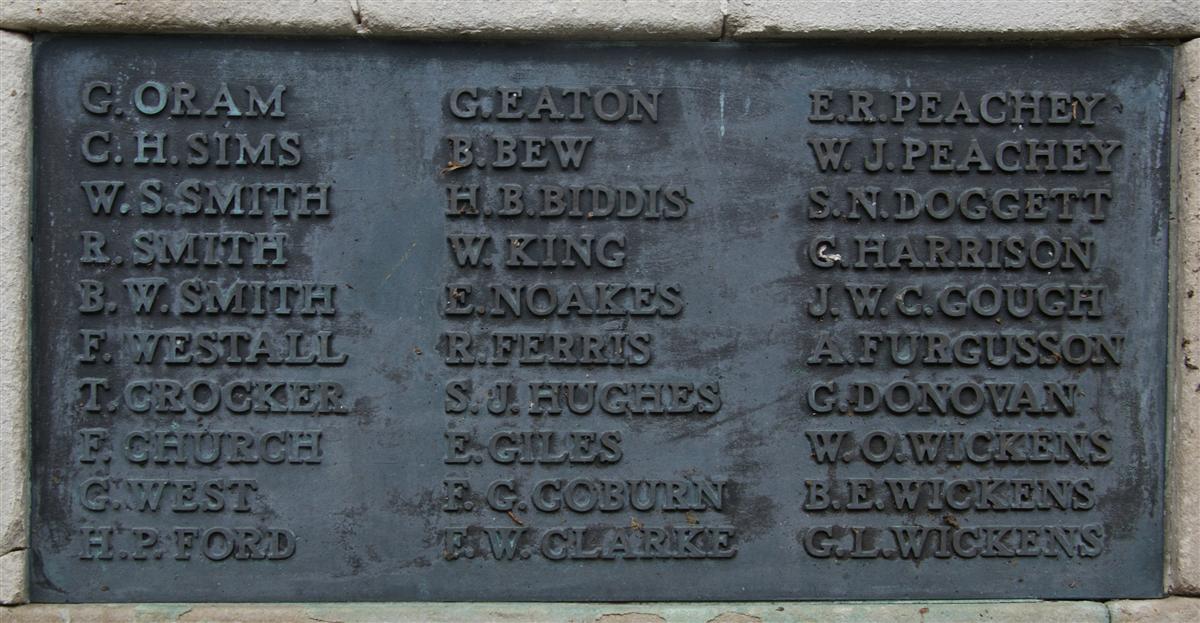Rupert Ferris
Private 97250 Rupert Ferris, 1st Battalion, Tank Corps

A view of Newbury Lock from Newbury Bridge, Rupert's birthplace, and the family home, was the lock keepers cottage far right. |
Rupert was born at the Lock Cottage in Newbury on 14 July 1898; he was the son of John Ferris and his wife Eliza (née Baker). As might be guessed from their address John was the keeper of the Newbury lock – the first lock built on the Kennet and Avon Canal around 100 years earlier.
Theirs was a large family, not unusual at the time; Eliza had a total of twelve children, two of whom died young. The survivors were Elizabeth Jane (born 1877), Ann Louise (1879), John Thomas (1881), George Thomas (1883), Ada Lotty (1887), Brice Edward (1890), Richard Alfred (1892), Walter Henry (1894), Stanley James (1896) and, the youngest, Rupert. One of the two who died was their firstborn, Eliza, who was born in Farmborough, Somerset (her mother’s home village) in 1876 and died in Newbury, aged 5. She was buried in Newtown Road Cemetery, Newbury, on 26 December 1881; it was not a happy Christmas for the Ferris family.
Rupert was educated in local schools, first at West Street Infants and then at St Nicolas’ National School in Enborne Road. He transferred from West Street to St Nicolas’ on 8 April 1907, one of sixteen boys to make the move up to ‘big school’. It is sobering to note that he was one of five from that group to die in the service of his country during the war (the others were William Annetts, James Bosley, Ernest Brooks and Jesse Buxey). Rupert remained at school until 12 July 1912, when, two days before his 14th birthday, he left to find work. Like many of his contemporaries he found employment as an errand boy – a typical job for youths in towns like Newbury.
On 25 June 1914 Rupert enlisted into the Royal Berkshire Regiment, telling them that he was eighteen years and eleven days old. On 29 June, when he arrived at Brock Barracks in Reading to start his military career, he passed the medical and was accepted into the regiment. It would seem that his introduction to army life was a rude one that failed to meet his expectations. The next day he went absent without leave; not that it took long to find him back in Newbury, where he was arrested by the police at 7.30pm on 2 July. At his disciplinary hearing on 9 July before Major F D Foley (Depot Commander) he was duly admonished and docked three days pay. However, during this process his true age came to light and a copy was obtained of his birth certificate. On the same day, 9 July, he was discharged from the army; the reason stated was that he ‘made a misstatement as to age on enlistment’. He was only 15 years and 360 days old - too young to serve. It is not clear why he made this attempt to enlist; perhaps he had lost his job as an errand boy (he was getting too old for such a role) and simply needed a job; perhaps he had dreams of an adventurous life away from Newbury. He could have re-enlisted as a boy soldier the following week, but didn’t – he had evidently had enough of the army for now.
So it was back to civilian life; it is not known what he did for a living, but he did get about a bit – on 10 October 1914 he was caught riding his bike without lights and was fined 5s, but not locally; he was caught riding on the London Road in Twyford, the other side of Reading, a long way from home with no lights – in the days when the police would commonly issue a summons for such behaviour.
His return to the army came when he was conscripted into the Army Service Corps (ASC). It would appear that this did not occur until February/March 1917, well after his 18th birthday, from when he would have been liable for conscription. Despite his young age Rupert got married, to Susan Williams, in 1916.
He was given the regimental number 316815 and trained as a driver in the Motor Transport arm of the ASC. By the time he was trained and ready to go overseas there was another, more exciting opportunity for ASC motor drivers in the newly formed and rapidly expanding Tank Corps where men with previous driving experience were in great demand. Rupert transferred to the new Corps and was given a new number: 97250.

Mk IV Tank - on display in Ashford, Kent. By Peter Trimming - Flickr, CC BY 2.0, Link |
Newbury Weekly News, 6 December 1917 – Local War Notes
Corpl R A Ferris, of Lock-house, Newbury, is enjoying home leave after eighteen months in France. Mr and Mrs Ferris have had five other sons serving King and country; Private Stanley, of the MT ASC, Gunner Rupert, of the Tank Corps; their two youngest sons are in France and Lce-Corpl Walter H, attached to the Red Cross Ambulance, has been invalided home from France, and is now stationed and Blackheath; while Gunner J T has lately been discharged medically unfit.
It is possible that Rupert was in France in time to take part in the Battle of Cambrai in November 1917, when the British used massed tanks (over 400) for the first time. After that battle the front settled down for the winter and the tanks were spread along the front to ensure there were some available to counter-attack should the enemy attack. The 1st Battalion of the Tank Corps, with which Rupert was serving, was allocated to the Fifth Army front. Fifth Army was holding the southern end of the old Battle of the Somme front plus another stretch to the south which the British took over from the French following the disastrous Nivelle Offensive in 1917. It was here that the Germans decided to strike.
Following the collapse of Russia a huge number of troops could be transferred from the Eastern Front to France. Hindenburg and Ludendorff decided to strike before the massive influx of US troops would be effective; the hope was to separate the British and French forces, drive the British to the coast and smash the much weakened French. It almost worked.

The badge of the Tank Corps, as used on a CWGC headstone. |
Things soon changed, the battalion soon began to lose Tanks, more due to mechanical failure than to enemy action.
The story of the battalion’s activities on 24 March is told in a report on the activities of the battalion in the opening days of the German Spring Offensive attached to the War Diary for March 1918 as Appendix 10.
War Diary, 1st Battalion, Tank Corps - 24 March 1918
[Note: Between 11.30 and 11.45pm on the previous day the battalion CO received information that local forces had received orders to withdraw to a line east of Maricourt. Acting on this and other information the CO gave the order to withdraw to the Maricourt line. All map references refer to Sheet 62C.]
One tank (No 2045, 2/Lt A G BAKER) C Coy was left behind owing to Mechanical trouble. He remained as a strong point and when the enemy appeared next morning held them up for a short time, finally evacuating and destroying the Tank.
7am Move to MARICOURT completed, 18 Fighting Tanks ad 8 tenders having arrived there.
Eight fighting tanks were fit for action and work was commenced on all unfit tanks.
9am I consulted with GOC, 21st Division at MARICOURT and arranged to send 8 fighting tanks into action at once on a front from MAUREPAS to the SOMME. These tanks were under the command of Major M L LAKIN DSO.
As the situation was very obscure and it was impossible to tell where tanks would be most needed, I gave Major LAKIN orders to use them as the situation developed where they appeared to be most required.
Major J C TILLEY MC was placed in command of the operation.
I established by Headquarters about 500 yards due East of MARICOURT on the PERONNE Road where I could be in close touch with OC 21st Division, and at the same time exercise control over my Battalion.
As a result of a reconnaissance by these two offcers it was decided to send 4 Tanks in the direction of B.21.central and B.28.central, under the command of Capt G Ingham MC, and four other Tanks in the direction of MAUREPAS to operate to the East of it, under Capt F S HUNNIKIN.
When the Tanks where in the region of A.23.b. it was seen that the enemy had broken through in the direction of HARDECOURT. Capt HUNNIKIN was accordingly despatched to operate between HARDECOUR and MAUREPAS and to the North of these places.
These last named Tanks succeeded in causing the infantry to retire some distance, and helped the infantry re-establish the line.
Two Tanks under Capt INGHAM proceeded through the valley towards the BOIS DE HEM. These Tanks failed to reach the enemy lines, one turning over on its side, the other being badly ditched, and were eventually destroyed on the enemy’s approach.
Two Tanks under 2/Lieut G MATTHEWS advanced to the North of the BOIS DE HEM, one of which, under 2/Lieut W BRADNEY was hit by a trench mortar and burnt out, the Crew joining the Infantry, all are missing.
The second Tank under 2/Lt C H BENNETT got into contact with the enemy, but the Differential broke; the crew remained with the Tank which was used as a strong point to cover the withdrawal of the infantry at dusk, which was done successfully, the crew having used their ammunition, fired the Tank and returned to MARICOURT.
1.30pm Two more Tanks being ready they were despatched to A.23.C.5.2 with orders to assist the Infantry between the PERONNE ROAD and the SOMME. One of the Tanks (4027) Lieut S HOULTON, became hopelessly ditched. The other Tank (2580) under Lieut A E OLDHAM proceeded from a mile to a mile and a half into the enemy’s lines, where if broke down. The Tank was repaired during the night, and returned next morning as far as our own front line where it again broke down and had to be abandoned. This Tank inflicted grave casualties on the enemy and according to reports caused considerable disorganisation behind the enemy lines and succeeded in holding him up for at least twelve hours.
4pm Four other fighting Tanks being ready for action were despatched under Capt A J FRASER, to the North, where the enemy had again broken through. His orders were to clear the village of HARDECOURT of the enemy with two Tanks (4698, Lt CARROLL, and 2656 Lt DINGLE) and with the other two TANKS, to engage the enemy on the spur SE of MAUREPAS. On the Tanks advancing the enemy retreated and the crews were not able to gain close touch or to do much shooting for want of targets, but they succeeded in helping re-establish the line, which had given way for a second time in this neighbourhood.
7pm Major J C TILLY MC and Major M L LAKIN DSO returned and gave me a situation report of the Tanks and Infantry.
As it was getting late and the Tanks were running short of fuel and ammunition, and moreover were in a precarious mechanical state, I decided in consultation with OC 21st Division to withdraw Tanks to MARICOURT.
All Tanks that could move had returned to MARICOURT by 11pm.
OC 4th Brigade gave orders on the spot for the Battalion to be withdrawn to 2nd Brigade Camp, the Tanks to be parked on the reverse slope North of the village of BRAY. This was accordingly done, with the exception of eight Lewis Gun teams which were left under Major H O C THORP, to man the defences of MARICOURT with the Infantry.
Four Lewis Guns and 24 Drums of ammunition were handed over to the Infantry as they were short.
At 12 midnight 24/25th Tanks all parked North of the village of Bray.
This was the day that Rupert is believed to have died; it is quite possible that he was a member of the crew of Lieutenant Bradney’s tank, which was disabled by a mortar bomb after which the crew joined with local infantry and had not been heard from by the time the report above was written? Lieutenant Walter Bradney, Private Arthur Gibbs and Lance Corporal Peter Marquis are the only other recorded casualties from the battalion that day; four casualties from a tank hit by a mortar bomb?
However, in the chaos and confusion a man could easily be lost, he may even have been in one of the tanks abandoned the previous day who disappeared while fighting alongside infantry or struggling to make his way back to his unit and was last seen by a colleague on the 24th.
What is confusing is that his family were originally notified that he went missing on 21 March, when the battalion did little of note.
Newbury Weekly News, 20 June 1918 – Reported Missing
FERRIS – Reported missing 21st March, No 97,250 Driver R Ferris, 1st Btt C Company, 2nd Section Tank Corps, BEF. Any information regarding the above named, will be gratefully received by his parents, Lock House, Northbrook-street, Newbury.
Eventually more news was forthcoming, which declared that Rupert had been killed in action on 24 March, near Maricourt – which ties in with the report of the battalion’s actions that day (above).
Newbury Weekly News, 12 December 1918 – Killed in Action
FERRIS – Reported missing March 21, now reported killed in action, March 24, at Maricourt, near Bray, 97250 Dvr Rupert Ferris, 1st Batt, “C” Company, 2nd Section Tank Corps, youngest son of Mr and Mrs Ferris, Lock House, Newbury, age 19 years and 8 months. His brother Stanley, now home on leave, confirms the sad report that he has visited the scene of his grave.
Our home is filled with sorrow,
Our aching hearts are sad,
For war has done its cruel work,
And robbed us of our lad.
But the hardest part is yet to come,
When the heroes all come home,
And we miss among the cheering lands
The face of our darling son.
 Rupert's name on Newbury War Memorial (centre) |
However, the report that Stanley had visited Rupert’s grave adds further confusion. Presumably he would have little opportunity for such a visit until hostilities ceased and certainly not before the Maricourt area was recaptured in August 1918. If a grave existed at that date, when the fighting had moved east for the last time, why does he have no known grave today?
Whatever the answer to this conundrum Rupert’s name is remembered on panel 94 of the Pozières Memorial to the missing at the southern entrance of the village of Pozières a few miles north of Albert.
His family then added a little more to the confusion by suggesting that he died of wounds:
Newbury Weekly News, 20 March 1919 – In Memoriam
FERRIS – In ever loving memory of Rupert dearly beloved youngest son of Mr and Mrs Ferris, Lock House, died of wounds received in action, March 24th, 1918, aged 19 years. – Peace, perfect peace. – From all at home.
Locally he is remembered on Tablet 11 of the Newbury Town War Memorial, the parish memorial board and roll of honour in St Nicolas’ Church.
FAMILY
As noted in the newspaper item on the family’s contribution to the war effort, four of Rupert’s brothers served in the army during the war:
Richard Alfred Ferris was born on 27 February 1892 and was less than keen to don a khaki uniform. He attempted to persuade the authorities that he should not be conscripted. This involved attendance at a local tribunal, which adjudicated on a great many appeals against the Army’s call to arms:
Newbury Weekly News, 11 May 1916 – Newbury Borough Tribunal
Richard Alfred Ferris, aged 24, of West Mills described as canal carrier and master carter asked for absolute exemption. He had two horses and two boats, and had been engaged in carrying goods on the canal, but trade having fallen off, he was now carrying goods from the railway for the Company’s delivery agent. If he were called up, he would have to sell his horses and boats, which would be a serious hardship to his mother, who would be deprived of most of her living. He had received notice to join, and there was not time to settle up. The Tribunal declined exemption.
So Richard had to go to war. Details of his service have been difficult to find, it is possible that he was Acting Corporal Richard A Ferris, 173097, Royal Engineers – the best fit for him in the Army medal rolls. There are, however, several other possible matches. He survived the war though it may have affected his health since he died relatively young in 1943. In 1920 he married Esther Sandford.
Stanley James was born in April 1896 and was schooled, as were all the brothers, at West Street and St Nicolas’ schools. He left school in March 1910 to work on a barge – having a lock keeper as a father had some advantages.
His service record was destroyed along with about 70% of all such records in a fire in 1940, but it seems likely that he too was conscripted in 1916. He served in the Motor Transport branch of the Army Service Corps, probably with the regimental number M2/177824. It was he who reportedly visited Rupert’s grave in 1918. He survived the war and, in 1920, he married Annie Peirce, whose brother William was another casualty of the war. Stanley died in 1966 aged 70.
Walter Henry, born 2 August 1894, enlisted into the Royal Army Service Corps (No T4/122789) on 7 July 1915 as a Driver. The prefix to his regimental number, T4, indicates that he served in a horse transport unit; unsurprising considering his peacetime occupation as a farm carter. After three months training in the UK he boarded the SS Queen Alexandra for an overnight crossing to Le Havre where he landed on 9 October 1915. He then spent periods with a couple of Divisional Trains (general transport for the Division) and 45th Field Ambulance (a forward medical facility, not a vehicle) before being posted on 2 May 1016 to the 47th Field Ambulance which he joined three days later. He was lucky enough to get leave starting on Christmas Day 1916 and was home for the New Year. On 22 May 1917 he was admitted to the 37 Casualty Clearing Station suffering from trench fever (then somewhat of a mystery disease but now known to be a bacterial infection). This resulted on his being invalided home to Rubery Hill Hospital in Birmingham, where he made a partial recovery. By July 1918 was deemed fit enough to be posted to 873 Company, Army Service Corps, at the Horse Transport Training School at Grantham, where he would be able to pass on his skills to new recruits. He was discharged in February 1919 with a small disability pension for an impairment that was deemed to be ‘less than 20%’. He died in 1972.
Walter lived in Hungerford (3 Salisbury Row, High Street) and is remembered on the roll of honour in Hungerford Town Hall.
John Thomas was the eldest of the brothers, born on 23 April 1881, but was still within military service age as determined by the Military Service Act of 1916, which introduced conscription. Like his younger brother Richard, an appeal was made against his call up, but not by John himself; in his case it was his employer, James Baverstock, who made the appeal in an attempt to avoid the loss of a valued employee:
Newbury Weekly News, 20 July 1916 – Newbury Borough Tribunal
The case of John Thomas Ferris had been adjourned for medical examination. His employer, Mr James Baverstock, reported that he was fit for home service. He was married, with five children. The tribunal adjourned the case until the man was called up.
Baverstock was a bit of a local character who evidently felt he was able to assess a man’s fitness! Unsurprising the members of the tribunal preferred to have a professional opinion. So he was assessed by a doctor and returned to the tribunal:
Newbury Weekly News, 3 August 1916 – Newbury Borough Tribunal
Mr James Baverstock, marine store dealer, Old Newtown Road, applied for John Thomas Ferris, scalesman, who had been medically examined and certified fit for general service. It was claimed that this business was of national importance, the materials collected being used in the manufacture of munitions. Exemption was refused.
Baverstock is usually described as a marine store dealer – in a town many miles from the sea, the only ‘marine’ business came from the canal (a fair distance from his premises in Old Newtown Road) and, as can be seen from Richard’s business problems, the canal was in terminal decline. In reality Baverstock was operating a scrap dealer’s. John’s case is unlikely to have been helped by the fact that he had, in fact, attested under the Derby Scheme on 11 December 1915. This scheme (also known as the Group Scheme) was a last ditch attempt to avoid the need for conscription that persuaded men to attest (sign up) in late 1915 for service at a later date as the need arose. It was popular with elder married men as the scheme promised to call up single men before married and elder men after younger. It is unlikely that John anticipated a call up as soon as mid 1916.
So John was called up and left his family (wife Alma née Huntley and children Harry Wilfred, Thirza Alma Elizabeth, Leslie Victor, Eric Hugh and Arthur Bertram) at their home in Boxford to join the Labour Corps on 25 August 1916. He served for a total of 1 year 353 days before being discharged medically unfit. In transpired that he had suffered from rheumatism in 1901 and that the rigours of army life and living in damp accommodation aggravated his condition leaving him with rheumatism in his hips, legs and shoulders. He was granted a small pension for a couple of years – on 6 January 1920 it was decided there were no grounds for any further pension awards.
There were two other brothers, George and Brice, who were not mentioned in the newspaper article
Brice Edward was born on 21 February 1890, well within the age group susceptible to conscription, but he did not serve. In 1906 he crossed the Atlantic and entered the USA via Canada. It is not known how long he stayed, but he crossed again in 1912, when he settled in Seattle, Washington, where he worked as a longshoreman (docker). This meant that he was not in the reach of the British military, but, when the USA entered the war in 1917 he had to register for the draft. The form he filled in gives the reason why he was very unlikely to ever serve either of his countries – he had a ‘crippled foot’. He remained in the US for the rest of his life dying in 1967.
The final brother, George Thomas, born in 1883, has proved the most difficult to research. After school he became an apprentice brickmaker (to Henry Hall) and is last recorded with Hall and a team of builders, mainly from Newbury, in St Leonard’s, Sussex, no doubt there on a temporary basis for as long as the job lasted. It is possible that he too emigrated.
+

